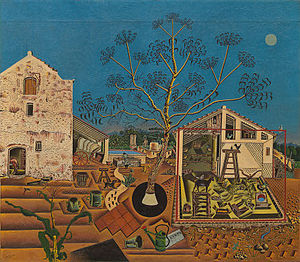The magical realism used by Joan Miro in this painting helps to understand The Farm, which was also the painter's family summer house in Mont-Roig del Camp.
As in the church of the people and Montroig paintings, the relationship between Miro and the rural land is clear from the painting's re-creation of the childlike, objectification of the Catalan pride and the individualistic style of painting. Miro focuses on each element detail separately and arranges them in a very precise and conscious form. Captivating are the daily farm activities, plants, traits of domestic animals, the building with cracks and crevices and the large eucalyptus tree in the centre, which is born of a black circle.
The realistic representation of each element shows the relationship between Miro and the farmhouse. Observing everything in the Catalan scene as the lights on the objects changed made him feel bound to the element earth. The patterned and flat background would become paramount in his mature styles in paintings such as Nude With a Mirror and The Table- Still Life With Rabbit. The objects and elements in The Farm became forms of prototypes symbol that would be in his other works. The painting was almost cut and sold as small pieces by Rosenberg to make more sales but Miro insistently refused.
"It has all that you feel about Spain when you are there and all that you feel when away and cannot go there...no one else has been able to paint these two opposing things," Ernest Hemingway said as he bought the painting and compared it to James Joyce's Ulysses. The Farm, also Miro's poetic perception of the Catalan countryside is known for its clarity of objects and defined strokes that can be easily recognised. Miro's work has greatly inspired artists such as Gorky, Pollock, Rothko, Motherwell and modern designers such as Paul Rand. "It is the summary of my entire life in the countryside, one period of my work and a point of departure for what was to follow," Joan Miro.




